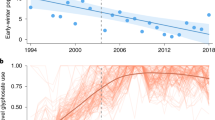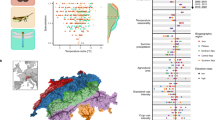Abstract
Climate warming is expected to change the distribution and abundance of many species1,2,3. Range shifts have been detected in a number of European taxa for which long-term government-initiated or organized-survey data are available4,5,6,7,8. In North America, well-organized long-term data needed to document such shifts are much less common. Opportunistic observations made by citizen scientist groups may be an excellent alternative to systematic surveys9. From 1992 to 2010, 19,779 butterfly surveys were made by amateur naturalists in Massachusetts, a geographically small state located at the convergence of northern and southern bioclimatic zones in eastern North America. From these data, we estimated population trends for nearly all butterfly species (100 of 116 species present) using list-length analysis10,11. Population trajectories indicate increases of many species near their northern range limits and declines in nearly all species (17 of 21) near their southern range limits. Certain life-history traits, especially overwintering stage, were strongly associated with declines. Our results suggest that a major, climate-induced shift of North American butterflies, characterized by northward expansions of warm-adapted and retreat of cold-adapted species, is underway.
This is a preview of subscription content, access via your institution
Access options
Subscribe to this journal
Receive 12 print issues and online access
$209.00 per year
only $17.42 per issue
Buy this article
- Purchase on Springer Link
- Instant access to full article PDF
Prices may be subject to local taxes which are calculated during checkout



Similar content being viewed by others
References
Parmesan, C. Climate and species’ range. Nature 382, 756–766 (1996).
Parmesan, C. Ecological and evolutionary responses to recent climate change. Annu. Rev. Ecol. Evol. Syst. 37, 637–669 (2006).
Mitikka, V. et al. Predicting range expansion of the map butterfly in Northern Europe using bioclimatic models. Biodivers. Conserv. 17, 623–641 (2008).
Parmesan, C. et al. Poleward shifts in geographical ranges of butterfly species associated with regional warming. Nature 399, 579–583 (1999).
Hill, J. K. et al. Responses of butterflies to twentieth century climate warming: Implications for future ranges. Proc. R. Soc. B 269, 2163–2171 (2002).
Hickling, R., Roy, D. B., Hill, J. K. & Thomas, C. D. A northward shift of range margins in British Odonata. Glob. Change Biol. 11, 502–506 (2005).
Franco, A. M. A. et al. Impacts of climate warming and habitat loss on extinctions at species’ low-latitude range boundaries. Glob. Change Biol. 12, 1545–1553 (2006).
Pöyry, J., Luoto, M., Heikkinen, R., Kuussaari, M. & Saarinen, K. Species traits explain recent range shifts of finnish butterflies. Glob. Change Biol. 15, 732–743 (2009).
Dickinson, J., Zuckerberg, B. & Bonter, D. Citizen science as an ecological research tool: Challenges and benefits. Annu. Rev. Ecol. Evol. Syst. 41, 149–172 (2010).
Szabo, J. K., Vesk, P. A., Baxter, P. W. J. & Possingham, H. P. Regional avian species declines estimated from volunteer-collected long-term data using list length analysis. Ecol. Appl. 20, 2157–2169 (2010).
Szabo, J. K., Vesk, P. A., Baxter, P. W. J. & Possingham, H. P. Paying the extinction debt: Woodland birds in the mount lofty ranges, South Australia. Emu 111, 59–70 (2011).
Cohn, J. Citizen science: Can volunteers do real research? BioScience 58, 192–197 (2008).
Silvertown, J. A new dawn for citizen science. Trends Ecol. Evol. 24, 467–471 (2009).
Beckage, B., Osborne, B., Gavin, D., Pucko, C., Siccama, T. & Perkins, T. A rapid upward shift of a forest ecotone during 40 years of warming in the Green Mountains of Vermont. Proc. Natl Acad. Sci. USA 105, 4197–4202 (2008).
Kelly, A. & Goulden, M. Rapid shifts in plant distribution with recent climate change. Proc. Natl Acad. Sci. USA 105, 11823–11826 (2008).
Rodenhouse, N. L., Christenson, L. M., Parry, D. & Green, L. E. Climate change effects on native fauna of northeastern forests. Can. J. Forest Res. 39, 249–263 (2009).
Leahy, C. W., Cassie, B. & Walton, R. K. Massachusetts Butterfly Atlas 1986–1990 (Massachusetts Audubon Society, 2006); available at http://www.massaudubon.org/butterflyatlas/.
Finkbeiner, S. D., Reed, R. D., Dirig, R. & Losey, J. E. The role of environmental factors in the northeastern range expansion of Papilio cresphontes Cramer (Papilionidae). J. Lepid. Soc. 65, 119–125 (2011).
Thomas, C. D., Franco, A. M. A. & Hill, J. K. Range retractions and extinction in the face of climate warming. Trends Ecol. Evol. 21, 415–416 (2006).
Bulman, C. et al. Minimum viable metapopulation size, extinction debt, and the conservation of a declining species. Ecol. Appl. 17, 1460–1473 (2007).
Pelini, S. L. et al. Translocation experiments with butterflies reveal limits to enhancement of poleward populations under climate change. Proc. Natl Acad. Sci. USA 106, 11160–11165 (2009).
Pelini, S. L., Keppel, J. A., Kelley, A. E. & Hellmann, J. J. Adaptation to host plants may prevent rapid insect responses to climate change. Glob. Change Biol. 16, 2923–2929 (2010).
Wallisdevries, M. & Van Swaay, C. Global warming and excess nitrogen may induce butterfly decline by microclimatic cooling. Glob. Change Biol. 12, 1620–1626 (2006).
Thomas, C. Extinction, colonization, and metapopulations: Environmental tracking by rare species. Conserv. Biol. 8, 373–378 (1994).
Schemske, D. et al. Evaluating approaches to the conservation of rare and endangered plants. Ecology 75, 584–606 (1994).
Scott, J. The Butterflies of North America: A Natural History and Field Guide (Stanford Univ. Press, 1992).
Opler, P. A Field Guide to Eastern Butterflies (Houghton Mifflin, 1992).
Opler, P. A., Lotts, K. & Naberhaus, T. Butterflies and Moths of North America, http://www.butterfliesandmoths.org/, Version 12/15/2011 (2011).
PRISM Climate Group. http://prism.oregonstate.edu (2012). Accessed Feb 19, 2012.
Acknowledgements
We thank B. Hall for assistance in producing figures, I. Myers-Smith for comments on earlier drafts, the MBC for graciously providing unfettered access to their extensive data set and Harvard University for financial and logistical support to conduct the analysis.
Author information
Authors and Affiliations
Contributions
E.E.C. and G.A.B. conceived the analysis. G.A.B. coded and implemented the analysis and created all figures. G.A.B. and E.E.C. wrote the manuscript. S.S. collected, organized and maintained the MBC observations database, provided help in understanding how the data were collected and archived, and provided feedback on earlier drafts.
Corresponding author
Ethics declarations
Competing interests
The authors declare no competing financial interests.
Supplementary information
Supplementary Information
Supplementary Information (PDF 1409 kb)
Rights and permissions
About this article
Cite this article
Breed, G., Stichter, S. & Crone, E. Climate-driven changes in northeastern US butterfly communities. Nature Clim Change 3, 142–145 (2013). https://doi.org/10.1038/nclimate1663
Received:
Accepted:
Published:
Issue Date:
DOI: https://doi.org/10.1038/nclimate1663
This article is cited by
-
Novel host plant use by a specialist insect depends on geographic variation in both the host and herbivore species
Oecologia (2023)
-
Butterfly population trends track vegetation encroachment but not climate warming in a Mediterranean mountain
Biodiversity and Conservation (2023)
-
LepTraits 1.0 A globally comprehensive dataset of butterfly traits
Scientific Data (2022)
-
Quantifying ecological variation across jurisdictional boundaries in a management mosaic landscape
Landscape Ecology (2021)
-
Responses of global waterbird populations to climate change vary with latitude
Nature Climate Change (2020)



